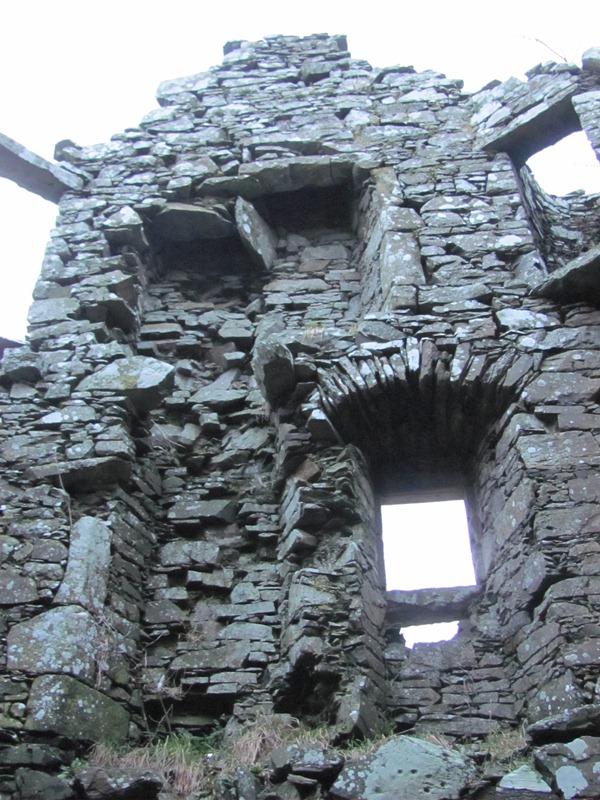According to the weather forecast the weather for the next couple of days looked a bit damp, so yesterday I thought I would go for a wee run while I could do it without getting too wet. First port of call was the small but quite delightful Kirkandrews Kirk which was built in 1906.
The lychgate - not a common site on Scottish churches. It takes it's name from the old English word for a corpse. In the middle ages the body would be brought to the gate and the priest would conduct the first part of the funeral from the shelter of the gate.
The church was closed yesterday but I've been before a few years ago and took these pictures of the inside.
Certainly must be cosy with the fire on.
A little further on the remains of the old Kirkandrews Kirk can be found. There is an 11th century cross from Kirkandrews at the Kirkcudbright museum and a church first appears in records here in 1275. All that remains of the old church now are a couple of low enclosures (perhaps).
In one of the enclosures is the rather gory coat of arms of the McClellan family (who built the castle in Kirkcudbright).The story goes that in the 16th century a bandit called Black Morrow (sometimes he is a gypsy, a moor or Irish depending on which version you hear) was making a pest of himself in the area of Kirkcudbright. James II promised the Barony of Kirkcudbright to whoever could rid the country of the problem. Sir Patrick MacLellan killed Black Morrow and became the 1st Lord Kirkcudbright, thus Black Morrow's head appears on the arms.
The graveyard here features a covenanters gravestone. According to the back of the gravestone it was reerected in 1855 by members of the parish so it's obviously not been standing all the time since 1685.
The tower from this collection of buildings can be seen from some distance away. They were built in 1916 as a dairy for a herd of 12 cows known locally as the Coo Palace. The tower itself was designed to be a water tower but was found not to be strong enough so it was used as a grain store.
It's in shocking condition. It's up for sale so if you fancy saving a fairly unique piece of architecture and have a spare pile of loot, you can get it here. I found this picture of the interior
This little turret is in the wall near the road.
Both wee kirk and coo shed and the next piece of architecture have a common connection - they were all built by James Brown (no not him!). James Brown was a wealthy Manchester merchant (also a authority on roses and employed a gardener just for roses) who retired to Knoxbrex estate in 1895. He built a fair selection of buildings of varying degrees of eccentricity on the Knockbrex estate until his death in 1920. This building below is built on the edge of Knockbrex house grounds in around 1900 and is known as the Toy Fort or Knoxbrex Castle (the term preferred it would seen by the people who would like to rent it to you for your holidays). Apparently it's based on Warwick castle.
Jim from the Glebe Blog saw Knockbrex House itself and James Brown's somewhat cookie bathing house in this blog.
I spotted Plunton castle from the road and after a wee drive about realised that there was no easy way to it. So I parked the car as tight into the side of the thin road as I could and made my was across the fields and a stream towards it. It's a L shaped tower house built in the mid 16th century by the Lennox family. There are signs of other buildings around the castle which have been suggested may be a walled garden and servants quarters. Others have suggested from earthworks that the castle may once have had a moat.
I read that the ground floor arrangement is quite unique among castles. Two cellars are to be seen here.
I seem to have an audience.
The remains of turrets in the corners
The stairs have long since fallen down but the walls seemed solid and it was fairly easy to climb up the first floor would have been the castle's hall I think. From there you could see fireplaces of rooms higher up the castle.
Some of the sheep wondering what the mad human is up to now.
History says little about Plunton castle but a poem by D Mclennan called The Tale of Plunton Castle describes it as the scene of bloody deeds. I haven't seen it I'm afraid but the poem fell into the hands of Sir Walter Scott who turned it into the play The Doom of Devergoil. In setting his play he writes,
"The scene represents a wild and hilly but not mountainous Country, in a frontier district of Scotland. The flat Scene exhibits the Castle of Devergoil, decayed and partly ruinous, situated upon a Lake, and connected with the land by a drawbridge, which is lowered. Time - Sunset"























